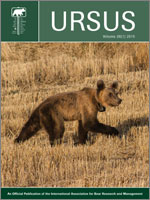The American black bear (Ursus americanus) is highly adaptable and can move long distances in short periods of time. The advent of Global Positioning System (GPS) –equipped telemetry equipment allows researchers to gather data on highly mobile animals with improved temporal and spatial resolution over standard telemetry equipment. We used a GPS-equipped radiocollar to document one of the longest non-dispersing movements of a black bear in New Mexico and Colorado (USA) during July 2011–May 2012, which is atypical because previously documented movements were generally associated with dispersal events. This adult male bear traveled a straight-line distance of 282.2 km (cumulative distance of 1,482.8 km) from the capture site. The bear made this long-distance movement in 304 days. It is unclear how common this type of movement is, but movements of this magnitude can potentially influence genetic diversity, recolonization potential, and have implications for managers in setting harvest regulations.
How to translate text using browser tools
1 May 2015
Extreme movement by an American black bear in New Mexico and Colorado
Stewart G. Liley,
Ryan N. Walker
ACCESS THE FULL ARTICLE

Ursus
Vol. 26 • No. 1
May 2015
Vol. 26 • No. 1
May 2015
American black bear
GPS
management
migration
movement
Ursus americanus




